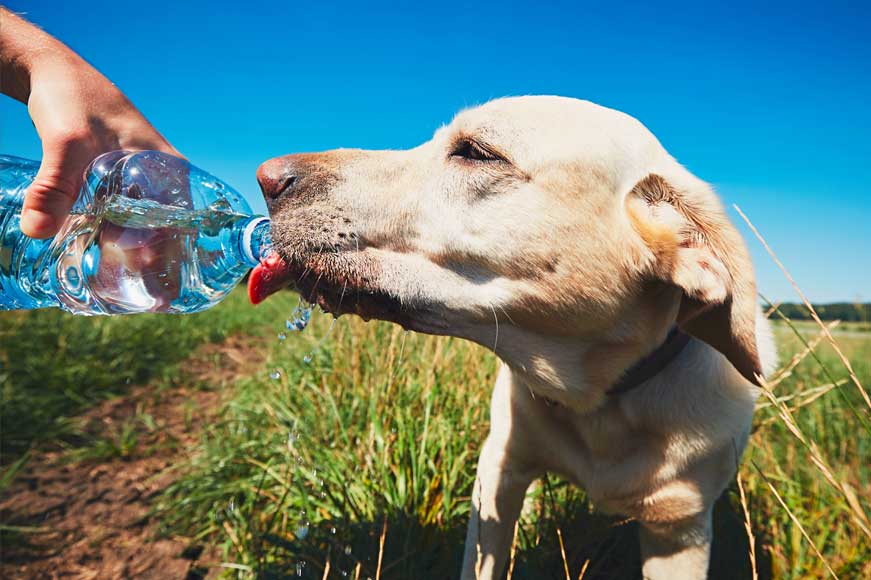Heatstroke in Dogs

Heatstroke is a serious danger for dogs. Dogs don't sweat as efficiently as humans do, as you can learn here: "Do Dogs Sweat?"
It's critical that all dog owners know how to recognize and prevent canine heatstroke.
What Causes Heatstroke in Dogs?
Dogs are susceptible to heatstroke when the environmental temperature is high enough for long enough that they are unable to cool themselves off effectively. The result is that the dog's internal temperature rises dangerously.
As a dog's internal temp rises, organ failure occurs, and death follows.
Dogs can die in just a few minutes if the external temperature is high enough, such as is the case inside a car when the temps are high outside.
Below are some situations and specifics that increase a dog's risk of heatstroke.
- Brachycephalic breed dogs, or those with short noses and flat faces like pugs, shih tzus, and Boston terriers are at higher risk of heatstroke.
- Dogs out exercising in the middle of the day, when it is hottest, are at high risk of heatstroke.
- Dogs left in cars on hot days are at extremely high risk of heatstroke.
- Young, elderly, or infirm dogs or those with respiratory conditions are at higher risk of heatstroke.
- Dogs left without fresh, clean water or shelter outdoors can develop heatstroke quickly on hot days.
Signs of Canine Heatstroke
Here are some of the signs of heatstroke in dogs:
- Heavy panting
- Glazed over eyes
- Listlessness
- Vomiting and diarrhea
- Bright red tongue and gums
- Weakness
- Extreme thirst
- Drooling
- Loss of consciousness
- Seizures
What to Do if You Suspect Heatstroke in Your Dog
If you are even a little bit concerned about heatstroke in your dog, act quickly.
First, move your dog to a cool location.
If he is conscious, offer him small amounts of cool water to drink. Don't let him gulp too much water at once because he may vomit, which will further dehydrate him.
If your dog is unconscious, check for a heartbeat and breathing. Perform rescue breathing or CPR as necessary.
You can take your dog's rectal temperature by inserting a flex-tipped thermometer and waiting for it to finish. A dog's temperature is normally between 100.4˚F and 101.5˚F. If your dog's temperature is between 102˚F and 104˚F degrees, keep him in the cool environment and continue to offer small amounts of water. Monitor his temperature every 5 minutes or so.
If your dog's temperature is over 104˚F, you can cool him down slowly by applying cool (not cold) wet towels to his neck, groin, and under his front legs. You can also use a hose with cool (not cold) water. Monitor his temperature every few minutes, and stop cooling him once it reaches 104˚F.
Remember, these are first aid steps, but you should call your veterinarian as soon as possible when you suspect a problem with your dog for individualized recommendations.
Prevention of Heatstroke in Dogs
As with most conditions, it's highly preferable to avoid heatstroke rather than to treat it. Here are some ways to avoid your dog succumbing to heatstroke:
- Keep your dog inside during the hottest part of the day.
- Never leave your dog alone in a car.
- Always make sure your dog has shelter and fresh, cool water when he is outside on warm days.
- Don't exercise your dog during the hottest part of the day.
Your dog can also get sunburned and suffer from paw pad burns from contact with hot pavement during hot weather, so be sure to guard against those conditions, too.
You May Also Like These Articles:
Foxtails: A Summertime Hazard for Dogs
First Aid for Heat Burns in Dogs
Dog Shaving: Helpful or Harmful?
Dog Safety on the Fourth of July
Black Widow Spider Bites in Dogs
Disclaimer: This website is not intended to replace professional consultation, diagnosis, or treatment by a licensed veterinarian. If you require any veterinary related advice, contact your veterinarian promptly. Information at DogHealth.com is exclusively of a general reference nature. Do not disregard veterinary advice or delay treatment as a result of accessing information at this site. Just Answer is an external service not affiliated with DogHealth.com.


